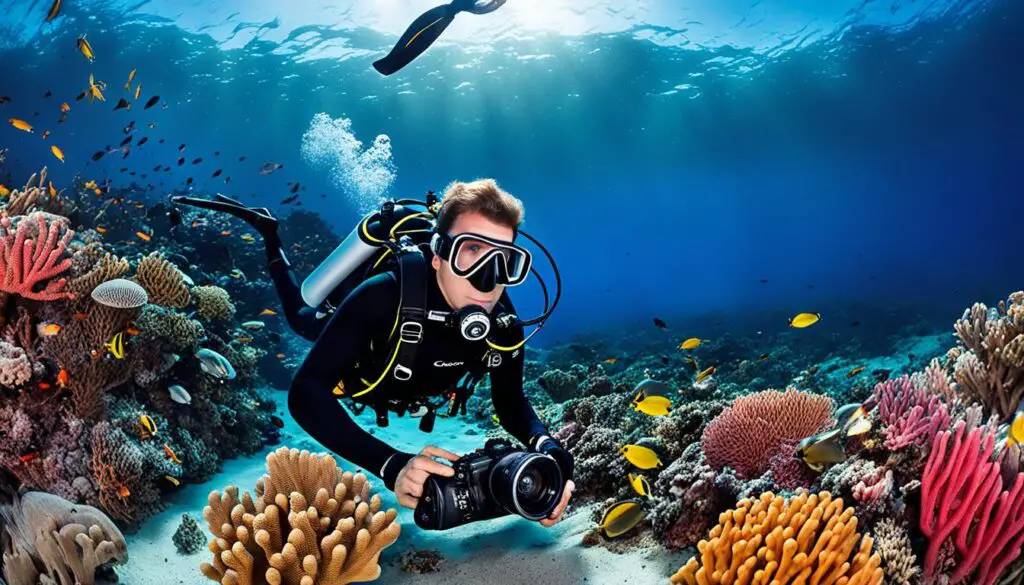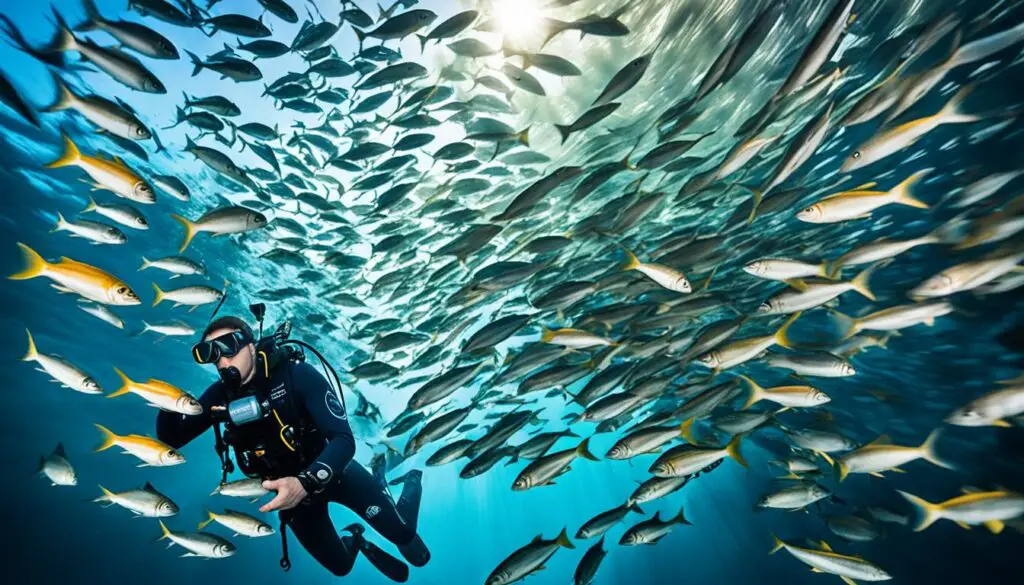Underwater wildlife photography is a captivating and challenging genre that allows photographers to explore and capture the hidden wonders of the ocean. Whether you’re an experienced photographer or just starting out, here are some essential tips to help you master the art of underwater wildlife photography.
Key Takeaways
- Choose the right gear, including a waterproof camera, underwater housing, lenses, and lights.
- Master essential techniques such as lighting, composition, and controlling buoyancy.
- Respect and appreciate the underwater world and preserve its fragile ecosystem through responsible photography practices.
Choose the Right Gear for Underwater Photography
When it comes to underwater photography, having the right gear is crucial. Investing in high-quality equipment ensures that you can capture the stunning beauty of the underwater world with precision and clarity. Whether you’re a professional or an amateur photographer, selecting the right gear can elevate your underwater photography to new depths.
Underwater Camera
The first and most important piece of gear you’ll need is a dedicated underwater camera. Look for a camera specifically designed for underwater use, as they are built to withstand the demands of the marine environment. These cameras are waterproof, durable, and equipped with manual control options to allow you to fine-tune your settings. Popular options include the Nikon D850 and the Canon EOS 5D Mark IV.
Underwater Housing
To protect your camera from water damage, it’s essential to pair it with the proper underwater housing. The housing should provide a secure and watertight seal, allowing you to take your camera to the depths without worry. Consider brands like Nauticam and Sea & Sea, known for their reliable and high-quality housings.
Lenses
Choosing the right lenses is vital in underwater photography as they determine the field of view and level of detail in your images. Wide-angle lenses are ideal for capturing the expansive beauty of underwater landscapes and the interactions between marine creatures. Popular options include the Canon EF 16-35mm f/2.8L III USM and the Nikon AF-S Nikkor 14-24mm f/2.8G ED. If you’re interested in capturing the intricate details of marine life, macro lenses such as the Canon EF 100mm f/2.8L Macro IS USM and the Sony FE 90mm f/2.8 Macro G OSS are excellent choices.
Underwater Lights
Lighting is crucial in underwater photography as it helps bring out the true colors and details of your subjects. Underwater lights are essential for illuminating the underwater world and adding brightness and clarity to your images. Strobe lights and continuous lights are commonly used depending on the preferences and shooting conditions of the photographer. Popular brands for underwater lights include SeaLife, I-Torch, and Light & Motion.
Equipping yourself with the right gear sets the foundation for successful underwater photography. Invest in a reliable underwater camera, pair it with a suitable housing, and choose lenses and lights that suit your shooting style and preferences. With the right gear, you’ll be well-prepared to capture the captivating beauty of the underwater world.

“Invest in a reliable underwater camera, pair it with a suitable housing, and choose lenses and lights that suit your shooting style and preferences.”
Master the Techniques for Underwater Photography
In order to capture stunning underwater photographs, it’s important to master the necessary techniques. Paying attention to lighting, composition, and buoyancy can greatly enhance the quality of your underwater images. Let’s explore these techniques in detail:
1. Lighting
Underwater environments can often be dimly lit, making lighting a critical aspect of underwater photography. Using strobes or continuous lighting can help illuminate your subjects and bring out their vibrant colors. Experiment with different lighting configurations to achieve the desired effect in your photos. Remember to position your lights strategically, allowing for proper exposure and minimizing unwanted shadows.
2. Composition
Composition plays a crucial role in creating visually appealing underwater photographs. Experiment with different angles and perspectives to add depth and interest to your images. Consider the rule of thirds, leading lines, and framing techniques to draw the viewer’s attention to your subject. By carefully composing your shots, you can create impactful and captivating underwater photographs.
3. Buoyancy
Controlling your buoyancy is essential for achieving stability and avoiding disturbances to the marine life while capturing underwater images. Maintaining neutral buoyancy allows you to move smoothly through the water and position yourself correctly for the perfect shot. Practice controlling your breathing and making gentle movements to minimize any disruption in the underwater ecosystem.
Additionally, be mindful of the water currents and adjust your camera settings accordingly. Fast-moving currents may require higher shutter speeds to freeze the action, while slower currents may allow for longer exposures and creative motion blur effects.
By mastering these underwater photography techniques, you’ll be able to capture stunning images that showcase the beauty of the underwater world. Remember to practice and experiment with different approaches to find your unique style. Now, let’s put these techniques into action and explore the mesmerizing world beneath the surface.

Dive into the World of Underwater Wildlife Photography
Underwater wildlife photography offers a unique and mesmerizing perspective of the ocean. Explore the depths and uncover the hidden beauty that lies beneath the surface. With the right techniques and equipment, you can capture the awe-inspiring marine life in all its glory.
Preserving the fragile ecosystem is paramount. Appreciate the underwater world and the delicate balance of nature. Through responsible photography practices, we can ensure the preservation of these mesmerizing creatures and their habitats.
So, grab your gear and dive into the fascinating world of underwater wildlife photography. Venture into the unknown, and witness the magnificent creatures that inhabit the depths. Explore, preserve, and appreciate the beauty that lies beneath the waves.
FAQ
What kind of camera should I use for underwater wildlife photography?
It is important to invest in a good underwater camera that is specifically designed for this purpose. Look for a camera that is waterproof, durable, and has manual control options.
Do I need to use underwater housing for my camera?
Yes, using an underwater housing is essential to protect your camera from water damage. Make sure to choose a housing that is compatible with your camera model.
What type of lenses should I use for underwater wildlife photography?
Consider using wide-angle lenses to capture the expansive underwater scenery, or macro lenses to capture the intricate details of marine life.
Should I use underwater lights?
Yes, underwater lights are recommended to add brightness and clarity to your images. They help illuminate your subjects in the dimly lit underwater environments.
How can I improve the lighting in my underwater photographs?
Experiment with strobes or continuous lighting to properly illuminate your subjects. Adjust the lighting angles and intensities to achieve the desired effect.
What techniques should I use to capture visually appealing underwater photographs?
Try out different angles and compositions to create visually stunning images. Pay attention to the water current and adjust your settings accordingly for sharp and focused shots.
How can I control my buoyancy while taking underwater photographs?
Mastering buoyancy control is crucial to achieving stability and avoiding disturbances to marine life. Practice controlling your movements to maintain a steady position underwater.
Why is underwater wildlife photography a unique perspective of the ocean?
Underwater photography offers a mesmerizing viewpoint of the ocean’s hidden wonders. It allows you to capture the beauty and intricacies of marine life that are not easily observable from above the surface.
How can I help preserve the underwater ecosystem through photography?
As an underwater wildlife photographer, it is important to respect and appreciate the underwater world. Strive to practice responsible photography techniques and support efforts to preserve the fragile ecosystem.
How can I explore the world of underwater wildlife photography?
Grab your gear, dive in, and start exploring the fascinating world of underwater wildlife photography. With practice and patience, you can enhance your skills and capture the captivating beauty of marine life.
